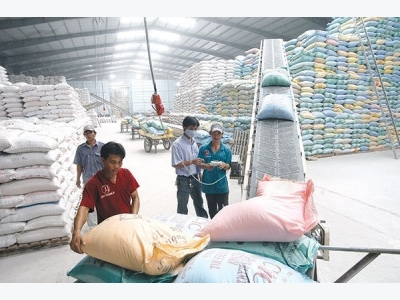Bottlenecks in rice production chain affecting market share

Vietnam’s rice production is meeting difficulties because of two bottlenecks at the ends of the production chain, leading to a decline in market share.
According to IPSARD, the first bottleneck is related to supply. Two-thirds of the rice surplus is in the hands of 20 percent of the biggest farmers – producers with an average cultivated area of 2.74 hectares.
Of 9 million households that grow rice, rice productivity from the biggest 300,000 households accounts for the large proportion of rice exports.
The ‘bulge’ in the rice value chain is processing. While rice cultivation depends on a number of large households, the processing is carried out at over 300,000 factories, most of which are small scale.
Vietnam’s rice production is meeting difficulties because of two bottlenecks at the ends of the production chain, leading to a decline in market share.
There are only 1,000 processing factories in Thailand.
The second bottleneck lies at the end of the chain – exports. There are only about 100 exporters, and only 22 exporters have licenses to export rice to China.
A report of the Ministry of Agriculture and Rural Development (MARD) shows that Vietnam’s rice exports in 2016 decreased by 27 percent in quantity and 23 percent in value compared to 2015, the lowest 8-year level.
The rice exports to China, Vietnam’s largest export market, have also decreased. The exports to choosy markets, including the EU, the Middle East and Sub-Sahara, account for only a few percent of total exports.
Rice demand to recover?
According to Sergio Araujo from FAO Rome, the challenges for Vietnam are that it needs to shift from low-cost to high-end rice and to distinguish between Vietnam’s rice and rice from other countries.
In fact, the competition in the high-end rice market segment is very stiff. Thailand has increased its high-end rice standards and set up a research institute for added value in the rice sector. India is focusing on improving technical standards for basmati rice and making efforts to increase the production of organic rice.
The demand for rice is on the decrease as people want products richer in protein such as meat, seafood, eggs and milk.
Meanwhile, according to Pham Kim Dung from IPSARD, Vietnam’s loyal markets are now applying necessary measures to ensure food security.
However, according to WB and IMF, the rice price still is moving up in the short term because of increased demand for storing rice.
Malaysia has decided to increase the import volume to 950,000 tons. Bangladesh has announced it would import 600,000 tons, considering supply from Vietnam.
Có thể bạn quan tâm
 Pork export to China remains tough
Pork export to China remains tough China will carefully check the disease control and quality of pork imported from Vietnam before officially opening up its market
 New generation corn turns around countryside poverty
New generation corn turns around countryside poverty Vietnamese farmers are getting rich by applying science and technology to their plantations.
 Cashew production forecast to drop nearly 20 percent in 2017
Cashew production forecast to drop nearly 20 percent in 2017 Vietnam is expected to harvest only 0.87 tonnes of cashew nuts per ha in 2017, 0.21 tonnes or nearly 20 percent less than 2016’s output per ha